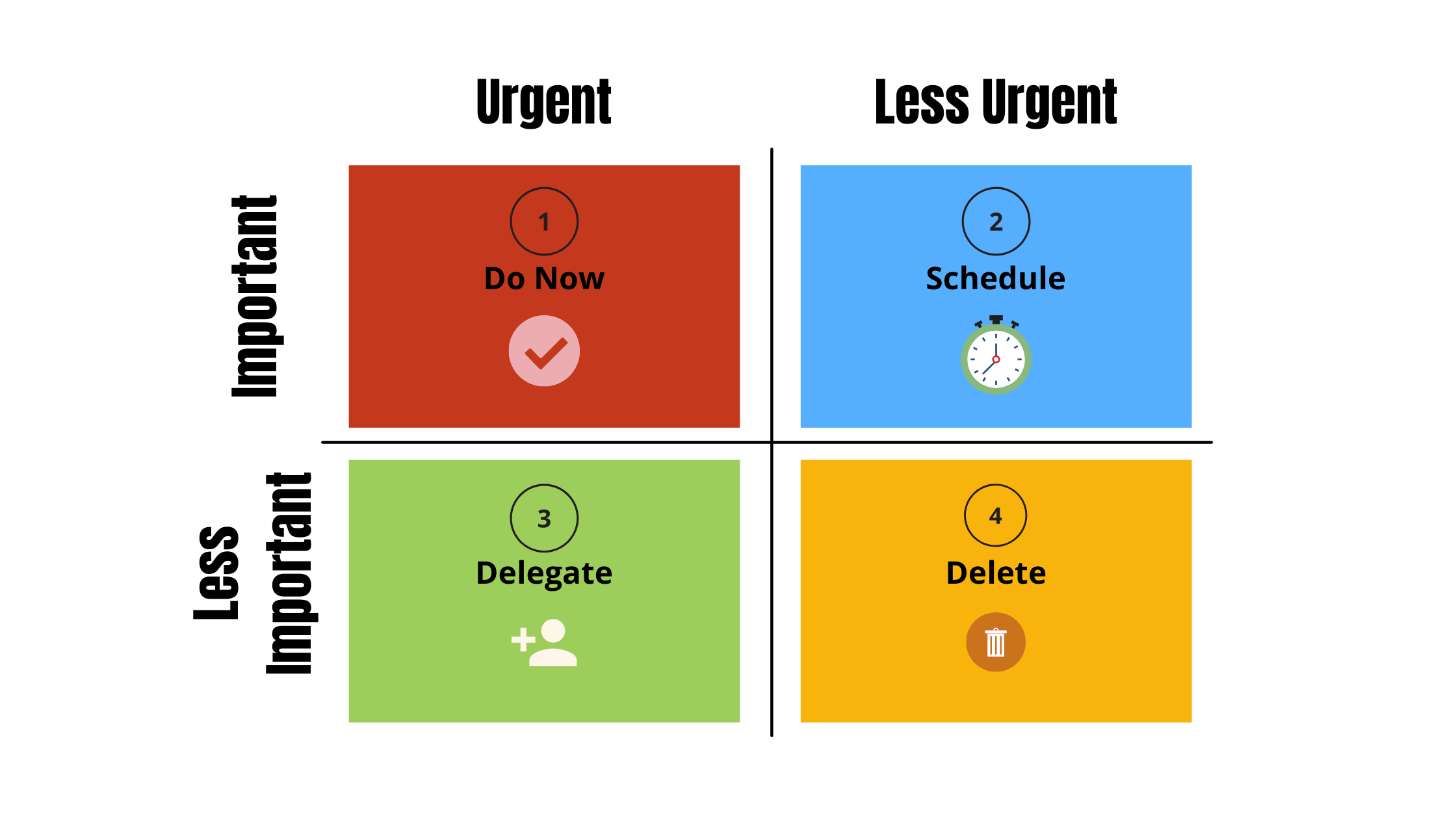We all face the daily challenge of dealing with many tasks, each demanding our attention with varying levels of urgency and importance.
Amidst this cacophony of to-dos, how do we ensure we’re not just busy but truly productive?
The Eisenhower Matrix is a straightforward yet transformative approach to task prioritization that empowers you to work smarter, not harder.
Origins of the Eisenhower Matrix
Named after Dwight D. Eisenhower, the 34th President of the United States, who was renowned for his incredible ability to sustain high productivity levels, the Eisenhower Matrix distils the essence of time management into a simple, four-quadrant box that helps distinguish the urgent from the important.
The Four Quadrants
The Eisenhower Matrix is divided into four parts, each representing a distinct category that tasks can fall into based on urgency and importance.
Quadrant I: Urgent and Important
Think of this as the ‘do it now’ box. It’s for non-negotiable tasks that demand immediate attention—like a crisis or a deadline looming large.
These are the fires that need putting out.
Quadrant II: Important but Not Urgent
This is where strategic planning, relationship building, and personal growth live.
Tasks here contribute significantly to our long-term objectives and values, but they’re often the first to be sidelined when something from Quadrant I comes calling.
Quadrant III: Urgent but Not Important
The deceptive quadrant. These tasks appear to need immediate handling but do not necessarily align with our goals or values.
They often involve others’ immediate demands—phone calls, some emails, or many meetings. It’s the art of delegation that’s tested here.
Quadrant IV: Not Urgent and Not Important
The trivial many. These tasks are the distractions of our daily lives, the ‘junk food’ of our productivity.
They offer little to no value and are prime candidates for elimination.

Source: The Biology Relay
Implementing the Eisenhower Matrix in Daily Life
Here’s how you can leverage the power of this tool:
- List Every Task: Empty your mind by listing every task or responsibility, vying for your attention.
- Assign Each to a Quadrant: Employ decisive judgment to categorize each task based on urgency and importance.
- Execute, Schedule, Delegate, or Eliminate: Approach each quadrant with its corresponding action—attend to Quadrant I tasks immediately, set aside dedicated time for Quadrant II tasks, delegate Quadrant III, and cut out Quadrant IV tasks wherever possible.
- Review Regularly: Reassess your tasks regularly, as priorities can shift. What was urgent yesterday may not be today.
The Philosophy In Practice
1. Focusing on the Quadrants
The matrix’s magic lies in balancing and integrating the four quadrants into your workflow.
While Quadrant I may demand immediate attention, the key to long-term success and peace of mind resides in Quadrant II.
By dedicating time to planning, self-development, and strategic thinking, you reduce the risks and the pressure of urgent matters.
Conversely, spending too much time in Quadrants III and IV can lead to stress and burnout; thus, learning to say no, setting boundaries, and recognizing what truly contributes to our goals are essential skills.
2. When Everything Seems Urgent and Important
In today’s fast-paced environment, the line between urgent and important often blurs.
Everything seems to require immediate attention, making it crucial to hone the ability to discern true priorities. Tools like the Eisenhower Matrix are not just about managing time—they’re about managing attention.
The art lies in distinguishing between truly urgent and important tasks, those that only seem urgent because someone else says so, and tasks that might be packaged as urgent but can actually be planned for more effectively.
3. The Quadrant II Habit
With its important but not urgent tasks, Quadrant II is where growth, innovation, and long-term vision thrive.
By fostering habits like proactive planning and setting aside uninterrupted time for these tasks, you’re investing in the foundations of your personal and professional life.
4. The Power of Delegation and Elimination
Delegation is not just about offloading work; it’s also an exercise in trust and empowerment.
By entrusting tasks that fall into Quadrant III, you free up your time for Quadrant II activities while enabling others to step up and take responsibility.
Similarly, diligently reducing Quadrant IV activities can liberate hours each week—time that can be better spent on Quadrant II pursuits.
The Impact of the Eisenhower Matrix on Personal and Professional Life
Adopting the Eisenhower Matrix isn’t a one-time setup.
It’s a continuous process that moulds to the evolving demands of life. It has a domino effect: as you become more adept at using it, it increases your productivity and creates a ripple effect that can improve team and organizational effectiveness.
The collective focus sharpens as more team or company members embrace prioritization.
The Bottom Line
The Eisenhower Matrix isn’t just a tool; it’s a mindset.
It instils a discipline of discernment that can differentiate between the genuinely critical tasks that propel us toward our objectives and the noise that can distract us.
It’s the ultimate guide in our quest to do more than stay afloat amid the relentless waves of demands—it’s the compass that helps us chart a course to personal and professional fulfilment.
So, take the time to reflect on your tasks. Sort, prioritize, and act with intention.
Nurture your productivity garden with the wisdom of the Eisenhower Matrix and watch it bloom with the fruits of your labours.
It’s a small investment in time management that yields rich dividends in achieving a balanced, accomplished life.
